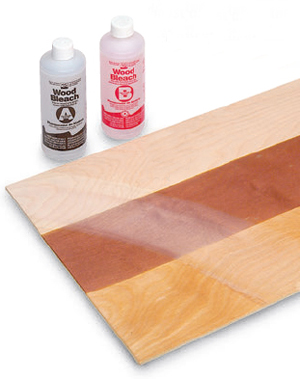
I have bought a 1915 house that is structurally sound, but it was badly abused by a previous owner who let dogs urinate on the hardwood floors and did not clean the stains. I read an article about bleaching wood in the “Finishing Secrets” Special Issue of your magazine (Winter 2011) on page 34. According to the advice given there, it seems like two-part wood bleach just might work to remove the urine stains. The man refinishing the floors says he will very lightly sand before I try to do anything to try and bleach them out. Three of the floors are 1/2-inch thick oak inlay, hence the most vulnerable. Two others are 3/4-inch quartersawn heart pine. The stains are extensive and very dark but I really want to try and “save” the old wood. It would be too costly for me to replace these floors. – Bettie Bradshaw
Tim Inman: Do NOT use two-part bleach except as a last resort solution. It is very aggressive and irreversible. It may “eat away” the wood fibers in your floor and worse. There are two issues to address here: One is color and the other is odor. Sanding should take care of staining and color problems. I live in a house made starting in 1903. Aged wood is part of the enjoyment of getting to live in an old building. We enjoy the photo developing chemical stains in my grandfather’s bedroom closet. It reminds us of him as a little boy. Pets and spills – and the evidence they leave – are part of living in old houses.
Odor is another thing, though. I don’t want to smell dog and cat pee every time the humidity goes up; unless you do something, you will. I would suggest talking with your local small animal veterinarian or pet expert. There are some very fine enzyme products available to cure just what you’re up against. A good “soaking” with one of these solutions prior to refinishing your old floor would be my first choice. Let the enzyme soak into the wood as far as the urine has been allowed to go in. Kill it all while you’re at it. I’m just not a big fan of bleaches.
Chris Marshall: Aged wood definitely enhances the character of an old home, but urine-stained “reminders” from the past just wouldn’t work for me. Hopefully, the sanding process will reveal that the urine stains are superficial and not deeply penetrating, but the deeper the damage, the more likely you’ll need to sand the entire floor to end up with a consistent appearance and a uniform top surface. Unfortunately, most of the wood’s patina will probably disappear when the old finish is removed. Pet urine stains in hardwood floors are problematic, to say the least. We had them once in the oak floors of an old home. In the end, we had to have the floors completely sanded and refinished. Afterward, the floors looked great, and we still had the original hardwood to enjoy. It was a good compromise, but it’s going to take many years for that old floor to look “old” again. Trade-offs might be inevitable.





